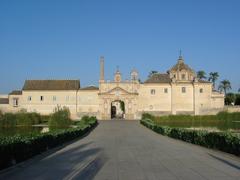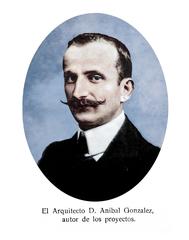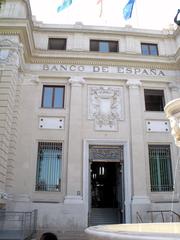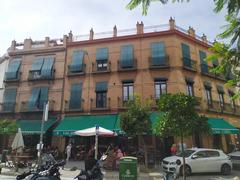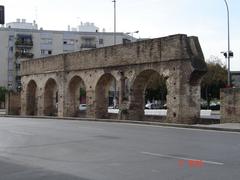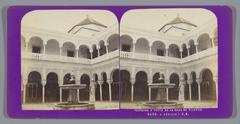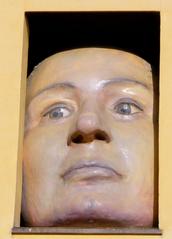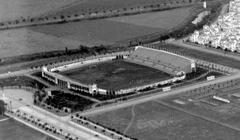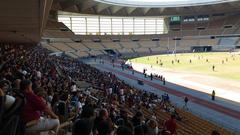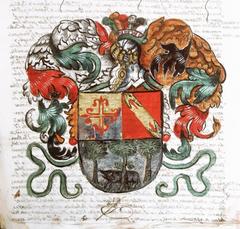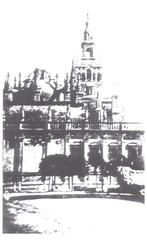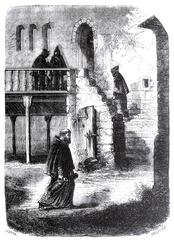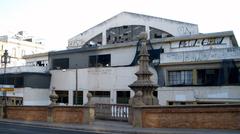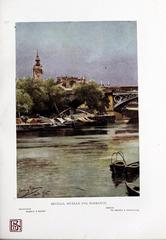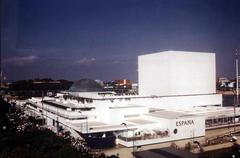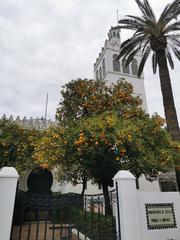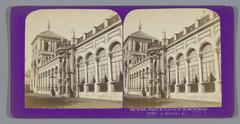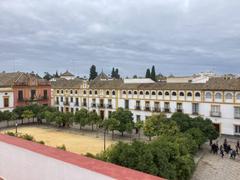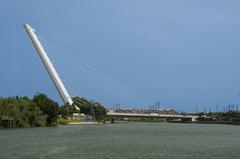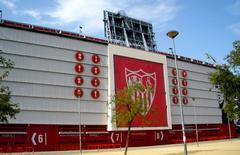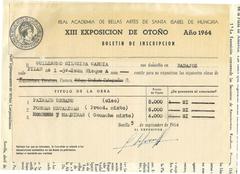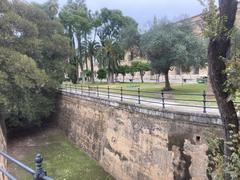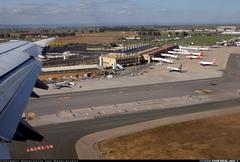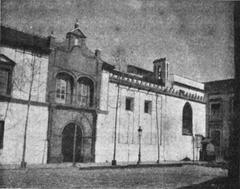Virgen Del Rocío Train Station: Visiting Hours, Tickets, and Travel Guide to Seville’s Historical Sites
Date: 04/07/2025
Introduction
Located in Seville’s vibrant southern district, the Virgen Del Rocío Train Station is more than a commuter hub—it is a gateway to Andalusia’s cultural heart, seamlessly connecting residents, pilgrims, and tourists to the city’s historic treasures and traditions. Established in the late 20th century and named after the revered Marian figure Nuestra Señora del Rocío, the station is integrally linked to Seville’s annual Romería del Rocío pilgrimage (Renfe Cercanías official site).
Situated near the University Hospital Virgen del Rocío and neighborhoods such as Los Bermejales and Bellavista, the station anchors Seville’s suburban rail network with Cercanías lines C1, C4, and C5. Its modernist architecture, accessibility, and advanced amenities make it a model of sustainable urban transit. Visitors will find themselves within easy reach of major attractions like Parque de María Luisa, Plaza de España, and the city’s historic center (Seville official tourism site).
This guide offers a detailed overview of Virgen Del Rocío Station: its history, cultural significance, ticketing and visiting information, accessibility, nearby attractions, and practical travel tips.
Table of Contents
- Introduction
- Historical Development of Virgen Del Rocío Train Station
- Visiting Hours, Tickets, and Prices
- Role in Seville’s Transportation Network
- Cultural and Religious Connections
- Socioeconomic Impact
- Integration with Urban Mobility
- Nearby Historical Sites and Attractions
- Visitor Experience and Practical Tips
- FAQ
- Notable Events and Future Prospects
- Virgen Del Rocío Hospital: Access and Visitor Information
- El Rocío Pilgrimage: Visiting Guide and Cultural Context
- Summary & Further Exploration
- References
Historical Development of Virgen Del Rocío Train Station
Origins and Urban Context
Virgen Del Rocío Station is named after Avenida de la Virgen del Rocío and honors the patroness of one of Andalusia’s largest religious events—the Romería del Rocío pilgrimage. Built in the late 20th century, the station was part of Seville’s suburban rail expansion, aiming to connect the growing residential areas of Los Bermejales and Bellavista with the city center and beyond (Renfe Cercanías official site). Its proximity to the Hospital Universitario Virgen del Rocío makes it a vital access point for healthcare staff and visitors.
Architectural Features and Modernization
Embodying functional modernist design, the station offers two platforms accessed via ramps and underpasses, ensuring accessibility for all travelers. Recent upgrades include electronic ticketing machines, real-time information displays, improved lighting, and enhanced security systems. The station is fully integrated into the Renfe Cercanías network, which operates more than 250 km of railway in the Seville area.
Visiting Hours, Tickets, and Prices
- Operating hours: Daily, with trains running approximately from 5:00 AM to midnight. Train frequency varies from 10 to 30 minutes depending on the time of day.
- Ticketing:
- Single journey tickets start at around €1.70, depending on the destination.
- Bonotren multi-trip passes provide savings for frequent travelers.
- Combinado Cercanías tickets are available for travelers connecting from AVE high-speed trains.
- Tickets can be purchased at station machines or through the Renfe Cercanías app and website (Renfe ticketing).
- Note: Cercanías tickets are not valid on city buses or Seville Metro services.
Role in Seville’s Transportation Network
Virgen Del Rocío Station is a key stop on Cercanías lines C1 and C4, providing direct connections to Santa Justa (the city’s main station), San Bernardo, and the airport bus terminal. Its integration with major roadways, bus routes, and bike-sharing stations supports multimodal travel and enhances mobility throughout southern Seville.
During the Romería del Rocío pilgrimage, the station becomes especially important as pilgrims use it to begin their journey to El Rocío (Official Romería del Rocío site).
Cultural and Religious Connections
The station’s name and location reflect Seville’s devotion to the Virgin of Rocío. While not a religious site itself, it plays a logistical role during the annual pilgrimage. The Romería del Rocío is a centuries-old tradition blending faith, music, and festive processions, drawing over a million participants each year (Official Romería del Rocío site).
Socioeconomic Impact
The station has catalyzed economic growth in southern Seville by improving access to jobs, education, and healthcare. Its location near the hospital supports both staff and patients, while local businesses benefit from increased foot traffic. By encouraging public transit use, the station helps reduce congestion and pollution in a city known for narrow streets and limited parking (Seville official tourism site).
Integration with Urban Mobility
Virgen Del Rocío connects seamlessly with city buses and nearby Sevici bike-sharing stations, promoting flexible and eco-friendly travel options. The station’s accessibility features—ramps, elevators, tactile paving—ensure inclusivity for all users.
Nearby Historical Sites and Attractions
From Virgen Del Rocío Station, visitors can conveniently explore:
- Parque de María Luisa: Expansive gardens and monuments, ideal for relaxation and sightseeing.
- Plaza de España: A renowned architectural landmark within the park.
- Museo Arqueológico de Sevilla: Fascinating archaeological collections.
- Seville Aquarium: Popular for families and nature lovers.
- Historic City Center: Home to the Seville Cathedral, Alcázar, and more, accessible via bus, taxi, or a pleasant walk.
Visitor Experience and Practical Tips
- Retain your train ticket until you exit the station—automated barriers require it.
- Plan transfers: Cercanías tickets do not cover buses or metro; separate tickets are needed.
- Check real-time schedules via the Renfe Cercanías app or website for up-to-date train information.
- Facilities: The station offers ticket machines, restrooms, waiting areas, cafeteria, vending machines, parking, Wi-Fi (limited), and security.
- Accessibility: Elevators, ramps, and clear signage ensure ease of use for travelers with reduced mobility.
FAQ
Q: What are the opening hours of Virgen Del Rocío Train Station?
A: Trains generally run from 5:00 AM to midnight. Check specific schedules before traveling.
Q: How can I reach Seville’s historic center from the station?
A: Use city buses, taxis, or walk (approx. 30 minutes) to reach major landmarks.
Q: Are there facilities for travelers with disabilities?
A: Yes, including elevators, ramps, tactile paving, and designated parking.
Q: Can I buy tickets for attractions at the station?
A: No, ticketing covers train travel only. Purchase attraction tickets online or at the sites.
Q: Is Wi-Fi available?
A: Free but limited Wi-Fi is available in main waiting areas.
Notable Events and Future Prospects
Ongoing investments in infrastructure, digitalization, and accessibility reflect Seville’s commitment to efficient and sustainable mobility. As tourism and high-speed rail expand, Virgen Del Rocío Station will play an increasingly important role in serving both residents and visitors.
Virgen Del Rocío Hospital: Access and Visitor Information
Overview
The University Hospital Virgen del Rocío is one of Seville’s most important medical institutions, named after the Virgin of Rocío and serving as both a healthcare and cultural landmark.
Visiting Hours & Access
- General visiting hours: Usually 12:00–2:00 PM and 6:00–8:00 PM, but confirm with the hospital as times may vary by department.
- Train: The adjacent Virgen Del Rocío station provides fast connections from central Seville (The Trainline).
- Bus, taxi, and cycling: Multiple options are available for easy access.
Facilities and Services
- Pharmacies, cafés, waiting areas, information desks, accessible restrooms, and security are available.
- The hospital is fully accessible for visitors with reduced mobility.
Practical Tips
- Plan your visit in advance and confirm department-specific rules.
- Parking is available but may be limited during peak times.
- Staff can assist in English; a translation app may be helpful.
El Rocío Pilgrimage: Visiting Guide and Cultural Context
Overview and Cultural Significance
The El Rocío Pilgrimage (Romería del Rocío) is a centuries-old festival rooted in Andalusian tradition, with Seville as a major starting point. The pilgrimage honors the Virgin of Rocío and draws nearly a million participants annually (Spain Savvy).
Rituals and Traditions
Pilgrims travel on foot, horseback, or in decorated carriages, wearing traditional attire and celebrating with music and dance. The highlight is the procession of the Simpecado banners and the culminating Mass at the Ermita del Rocío (Mundiplus).
Visiting Hours and Tickets
- Ermita del Rocío: Open daily 9:00 AM–8:00 PM, with extended hours during the pilgrimage.
- Pilgrimage events in Seville: Processions start early morning in the days leading up to Pentecost.
- Tickets: No ticket is needed to observe or join the pilgrimage; events are public.
Accessibility and Practical Tips
- Some pilgrimage routes involve rough terrain; accessibility varies.
- In Seville, most related events are accessible by public transport and suitable for visitors with mobility needs.
- Luggage storage is available near the train station (Eelway/Bounce).
- Comfortable shoes, sun protection, and respectful attire are recommended.
Nearby Attractions
- In Seville: Parque de María Luisa, Plaza de España, Barrio de Triana, Seville Cathedral, Royal Alcázar, Metropol Parasol (Touropia; Welcome to Seville).
- Outside Seville: El Rocío village, Doñana National Park, Córdoba, Huelva, and the Atlantic coast (Go Travel Daily).
Frequently Asked Questions
Q: Do I need tickets for the pilgrimage?
A: No, participation and viewing are free.
Q: When is the best time to experience the pilgrimage?
A: During Pentecost weekend; processions begin several days beforehand.
Q: Are guided tours available?
A: Yes, several operators offer tours with historical and cultural context.
Summary & Further Exploration
Virgen Del Rocío Train Station exemplifies Seville’s commitment to blending modern connectivity with deep-rooted cultural and religious traditions. Its location near major hospitals, residential neighborhoods, and historical attractions makes it indispensable for daily commuters, pilgrims, and tourists alike (Renfe Cercanías official site; The Trainline). The station’s association with the Romería del Rocío pilgrimage, proximity to iconic sites, and role in sustainable urban mobility position it as a central hub for anyone visiting southern Seville (Visitasevilla).
Whether you are attending a festival, visiting the hospital, or exploring Seville’s rich history, Virgen Del Rocío Station ensures a seamless and rewarding experience. For up-to-date travel information, schedules, and local event news, consider downloading the Audiala app and following Seville’s official tourism channels.
References
- Virgen Del Rocío Station in Seville: Visiting Hours, Tickets & Travel Guide, 2024, Renfe Cercanías official site (https://www.renfe.com/es/en/servicios/cercanias)
- Virgen Del Rocío Train Station: Accessibility, Facilities, and Nearby Attractions in Seville, 2024, The Trainline (https://www.thetrainline.com/es/estaciones/sevilla-virgen-del-rocio)
- Visiting the University Hospital Virgen del Rocío: History, Access, and Visitor Information, 2024, The Trainline (https://www.thetrainline.com/en/train-times/seville-to-sevilla-virgen-del-rocio)
- El Rocío Pilgrimage in Seville: Visiting Hours, Tickets, and Nearby Attractions, 2024, Visitasevilla (https://visitasevilla.es/en/seville-el-rocio-the-passion-that-unites-two-worlds/)
- El Rocío Pilgrimage cultural overview, 2017, Spain Savvy (https://spainsavvy.com/2017/06/07/spain-savvy-culture-corner-rocio-pilgrimage/)
